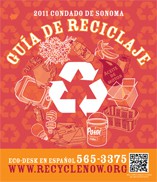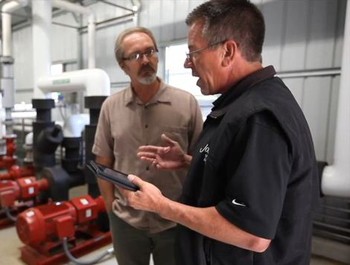 |
No matter how much is invested in the technological side of continuous efficiency efforts at any winery, no program can really take root and thrive without the understanding and engagement of the people who make up the organization. |

|
Stakeholders
Getting your entire staff on the same page is an essential part of getting a culture of sustainability to take root in your organization. It is the missing fourth E of sustainability—engagement. With everyone on the same page, you greatly reduce the potential for miscommunication, misinformation, misdirection, mistakes and mistrust. Instead, you’re positioned to generate the alignment necessary to move everyone in the same direction in the most efficient and effective manner. Employees at all levels of the organization are the knowledge network of your company, and it is their authentic engagement that is required for innovation, creativity and ideas that will keep the business viable well into the 21st century.

Internal - Employees, Board, Shareholders
The Importance of Alignment: Companies invest enormous amounts of time, energy and money trying to bring employees together and get them headed in a defined direction in order to achieve specific goals. Alignment maximizes efficiency and effectiveness. If each department determines its own direction the company experiences fragmentation. Individuals take off in ten different directions without a common mission. Sustainability goals always have to be placed in context, and always involve all of the people you work with. Imagine that your shipping department recently switched to recyclable shippers and your operations manager put the lights in the barrel rooms on timers but not everyone was aware of these changes. There needs to be a system for inter-departmental communication so there is a shared understanding of what’s being done and how these changes contribute to the long-term priorities of the company. The ingenuity of individual employees should be recognized and everyone should understand how their actions fit into the larger sustainability strategy. In order for this creativity, innovation and motivation to become organized and aligned, company leaders must not only articulate short-term and long-term goals, but they must ensure that employees are aware of them and be prepared to engage in an ongoing dialogue; you need to ensure that all of your employees understand where you are heading, why, and how you plan to get there. The best way to do this is by using the data and information collected from the identified indicators to communicate your story. Everyone likes a good story, especially when they are a part of it! Of course we recognize that this is a big challenge. Organizations, by their very design, are compartmentalized and siloed, keeping people separated by job description into independent departments where the only information they receive is on a “need to know” basis. But sustainability is about integrated systems – everything is connected to everything else. Information needs to be shared openly because everyone is involved in the survival of the entire enterprise. As we emphasize, sustainability is a path - a process of continual improvement. This is where we come in. ViewCraftworks directly with business “captains” to help them collect and organize the data needed to identify leverage points, and use these opportunities to develop and communicate a plan of action. We also work with each of the departments to layout how these strategies will be implemented, but we work with leadership to chart the course. And we help you get employee buy-in for positive change throughout the entire company by organizing, integrating and leveraging all of your collective efforts. |
|
External – Customers, Vendors, Distributors, Industry Peers, Regulators
The easiest way for us to communicate just how critical it is to engage in a dialogue about your sustainability efforts is through a few stories from clients we’ve worked with over the years:
 Let me get a manager
Let me get a manager
A few years back we were working with a winery on a purchasing audit to set the foundation for a new environmentally preferable purchasing initiative. Of course one of the biggest purchasing decisions wineries make is which shipping materials to use. This winery wanted to make sure that shipping boxes were made with at least some recycled content and could be reused or recycled. They were already using pulp shippers for most of their wine club shipments. The plan was to use this information to create a green card to place in each of their shipments. We made a call to the company where they purchased their boxes to ask a few simple questions. The first person we spoke with didn’t know whether the boxes contained recycled content or if they were recyclable. He got a manager who said he was fairly certain the boxes were recyclable but he also didn’t know about recycled content. The term actually seemed to be new to him. He said no customer had ever asked them this question before. Ultimately, the company was able to confirm the percentage of recycled content and that most boxes were recyclable. We’re glad future customers will have an easier time getting these questions answered!
 Ribbons and bows
Ribbons and bows
One of our consultants was talking with a winemaker with a small private label about environmentally preferable purchasing. He had been exploring different ways of integrating sustainability into his production process, from experimenting with aspects of Biodynamic farming to purchasing recycled content bottles. He acknowledged that capsules are often just a showpiece – not necessary to preserve the quality of the wine. With his latest vintage this winemaker decided to leave off the capsules, but he forgot to take a critical step – informing his distributors, and by proxy his customers, that the capsules were left off for a reason. When his wine shipment arrived in Chicago the distributors panicked, thinking there had been a serious mistake. They called frantic to figure out how to fix the “problem.” When it comes to changes in the way you do business, particularly social and environmental improvements, it is both necessary and beneficial to make sure everyone understands why the changes were made.
 What’s that old saying about when you assume?
What’s that old saying about when you assume?
Even with “educated” customers no company can afford to assume that their customers don’t need or want additional information. Case in point—several years ago when there was a spotlight on getting genetically modified organisms (GMOs) out of our food supply, customers at the Berkeley Whole Foods store began objecting to a “Heritage Clone Zin” in the wine section. This outrage prompted the manager of the store to contact the winery to say that they would have to pull the wine from the shelves because they could not carry wine made from GMO grapes. Of course this was a misunderstanding, and the winery quickly produced shelf talkers that educated the savvy shoppers that “clone” was a viticultural term and had nothing to do with GMOs. We are happy to report that the wine has since been selling well.
 You might want to get that certified
You might want to get that certified
We knew 20-years ago that the idea of green business certification was a good one when we helped create the first county Green Business Program. We received one of our prized compliments a few years ago after we helped develop and launch the Napa Green Certified Winery program. The keynote speaker at the launch event was Yvon Chouinard, founder of Patagonia. After his talk Yvon was interviewed by the Wine Spectator and was asked what he thought about the program. “I’ve been at this for over 30-years and this is the best, most well-thought out program I’ve ever seen.” That’s the best certification we’ve ever had.
 Skipping stones
Skipping stones
Sometimes the ripples spread from an organization into the community faster than we realize. After working with the Director of Sustainability at Windsor Vineyards a few years ago, we helped coordinate an employee recycling training session in Spanish – a free resource to businesses in Sonoma County. This 30-minute session included free pamphlets and charts in Spanish, showing all of the items that can be recycled and those that cannot. Two weeks later, the Director contacted us to say that several employees had told him how valuable the training was. Not only did the recycling rate increase at the winery but the employees had also taken the pamphlets home and passed them around the neighborhood. Through the dissemination of a few simple resources Spanish-speaking members of the community were empowered to participate in recycling efforts. Truly a situation where everyone wins!





